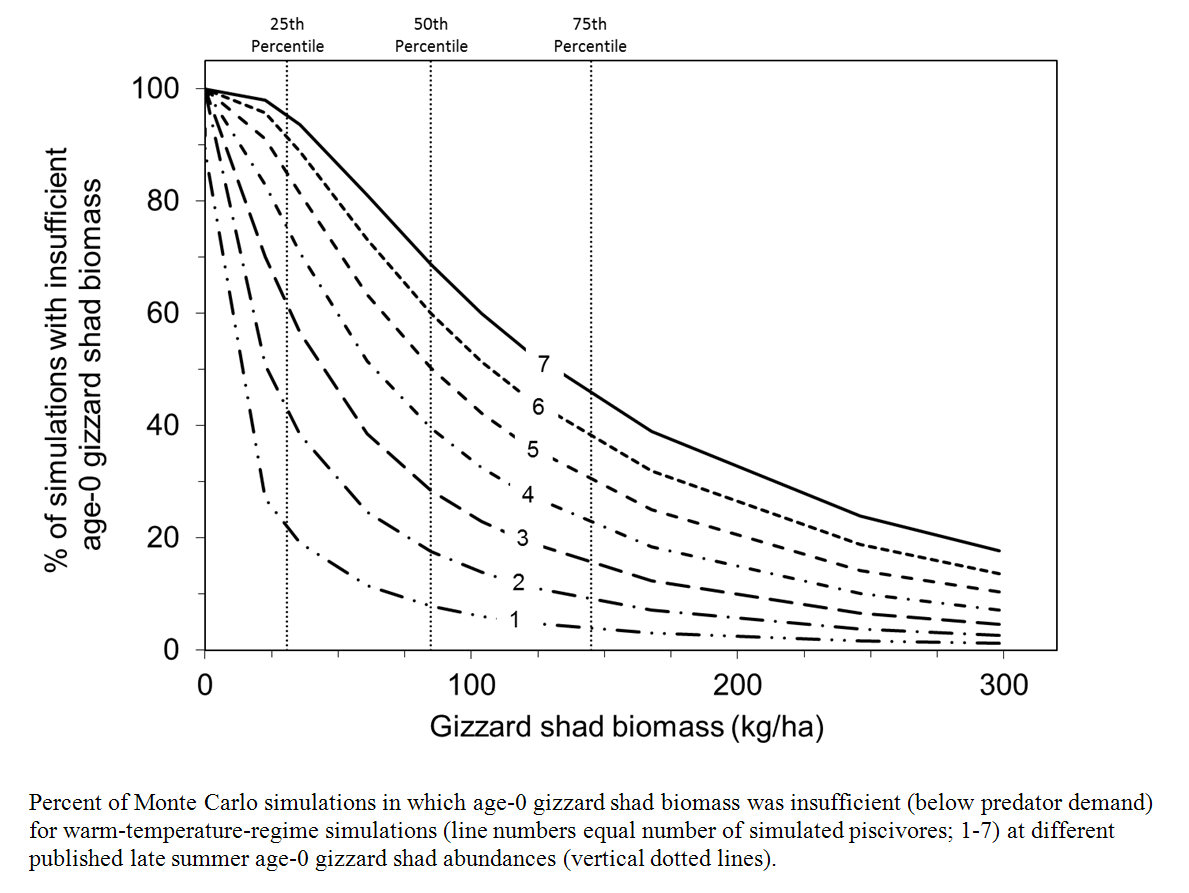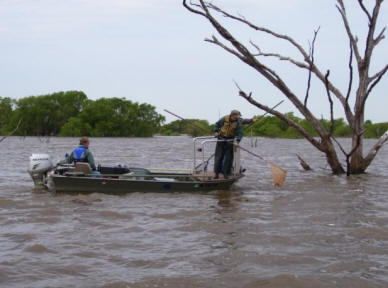Predator demand for gizzard shad in southern reservoirs
Project personnel: Nathan Evans, Dan Shoup
Evans, N.T.*, Shoup, D.E., and Glover, D.C. A simplified approach for estimating age-0 gizzard shad prey supply and predator demand. Fisheries Management and Ecology. 21:140-154. (Supplemental data tables)

Gizzard shad Dorosoma cepedianum, the primary prey in many lakes and reservoirs of the southern U.S., often comprise a majority of the prey biomass in the systems in which they are found. However, they rapidly grow to a size that surpasses the preferred prey sizes of most piscivores. Lakes and reservoirs may, therefore, be prey limited if age-0 gizzard shad abundances are low. Previous studies have not considered the effect of the prey supply of age-0 gizzard shad on the entire piscivore community in a reservoir or the effect of age-0 gizzard shad availability on the growth and condition of piscivores in reservoirs. This study used bioenergetics modeling and Monte Carlo simulations to quantify the abundance of age-0 gizzard shad necessary to sustain seven sport fish species, common to the southern U.S., at diverse growth rates, population sizes, mortality rates, and proportions of gizzard shad in piscivore diets.

Annual gizzard shad consumption estimates for individual piscivore species ranged from < 0.01 to 482.5 (kg/ha/year). Annual necessary gizzard shad abundance (accounting for non-predation mortality and reproductive surplus required for prey sustainability) estimates ranged from < 10/ha/piscivore population to > 128,000/ha/piscivore population. Monte Carlo simulations indicated that gizzard shad abundance at the 50th percentile of published age- 0 gizzard shad abundances was insufficient to support piscivore communities ≥ 69% of the time. Only in lakes with gizzard shad biomass > 75th percentile did Monte Carlo simulations have better than a 50:50 chance of having sufficient prey availability. Current findings support the hypothesis that systems must have high prey resource availability to support diverse sport fish communities with high-condition and abundance.

You can estimate the age-0 gizzard shad abundance required to sustainably meet predator demand for your reservoir using our calculator spreadsheet (which is based on the published supplemental data tables from our manuscript). You can even use this tool to see what would be needed to meet a new set of population parameters you may have as a management goal. To use the tool, enter a 1, 2, or 3 for each population parameter for each species to indicate if it is average (2), below average (1, indicating the lake is in the bottom 25% of lakes), or above average (3, indicating the lake is in the top 25% of lakes) with respect to that population parameter. If your lake does not have one of the species in the spreadsheet, enter 0’s for all population parameters. Then enter a 1, 2, or 3 (same scale as above) for the shad production potential (a measure of shad growth rate, fecundity, and mortality rate). The spreadsheet will then tell you how many kg/ha of age-0 gizzard shad in order to meet predator demand (and will also interpret the calculated biomass value based on where it would rank relative to systems across the U.S. in case you do not typically measure shad biomass and would rather know if this is close to average or not). If you are unsure how to rate one of the population parameters for a species, click on the blue box at the right of that species’ row to see the population parameters associated with a 1, 2, or 3 for that parameter.
Click the image below to download spreadsheet calculator tool.



